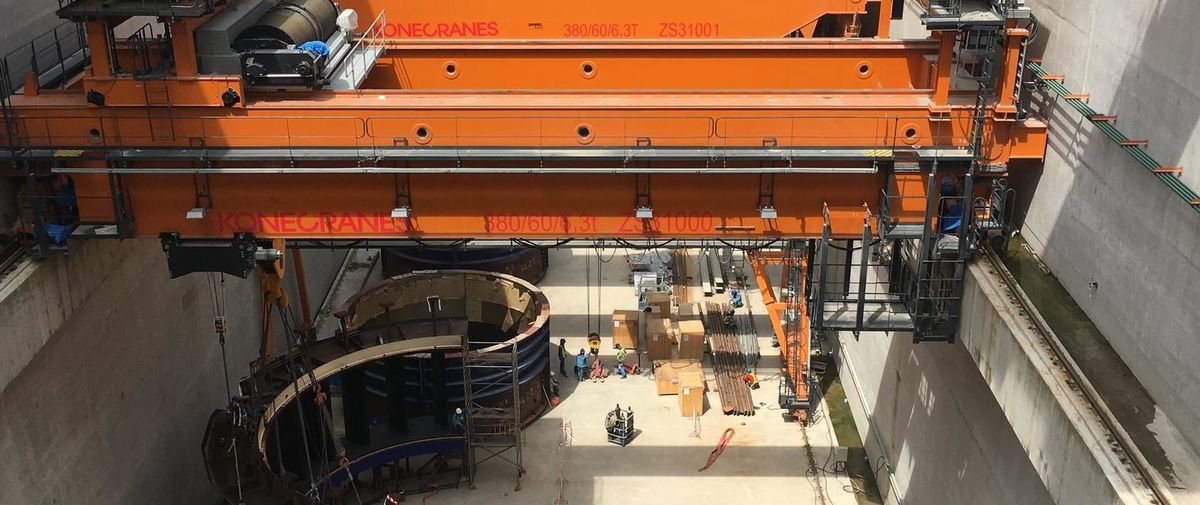At Xayaburi Hydro Power Plant (HPP), Laos, leading hydro engineering supplier Andritz is benefiting from the safety and efficiency of Konecranes heavy-duty open winch cranes to lift and accurately position the biggest hydropower turbines in Southeast Asia.
Located on the Lower Mekong River, approximately 30 kilometers east of Xayaburi, a town in northern Laos, the Xayaburi HPP is one of the largest hydroelectric projects in the region. When the project is fully completed in 2019, the total installed capacity is expected to be 1,285 megawatts, with a total annual energy production of around 7,400 GWh.
Two 380/80-ton SM cranes are used to lift tailor-made turbine components weighing hundreds of tons and position them in the powerhouse, which is environmentally harmonious by design. It avoids harm to fish in the Mekong River, home to over a thousand fish species.
“We chose Konecranes for the challenging task of lifting and accurately positioning turbines, generators and components because they have a world class reputation for safety and reliability and Xayaburi is one of the biggest hydro power projects,” says Harald Taubenschmid, Project Manager – Xayaburi HPP, Andritz Hydro.
We chose Konecranes for the challenging task of lifting and accurately positioning turbines, generators and components because they have a world class reputation for safety and reliability.
Andritz is a globally leading supplier of plants, equipment, and services for hydropower stations, the pulp and paper industry, the metalworking and steel industries, and for solid/liquid separation in the municipal and industrial sectors. The company has over 250 sites worldwide.
Compact design and custom features
“The Konecranes units not only lift enormous weights very efficiently, but they can fit into confined spaces too, which is a major advantage when working on a project like Xayaburi,” Mr Taubenschmid adds.
The extremely compact design of Konecranes’ SM trolley leads to minimized approach dimensions and headroom. Compared to conventional trolley types, the SM crane gives a reduction in the structural requirements of rails, runway beams and columns, and in the overall height of the building. Its compact design and economy of space allow for streamlined production areas and smaller buildings with bigger cost savings.
Konecranes was able to draw upon its decades of global experience in producing cranes for the power industry when it provided recommendations for features for Xayaburi.
Both SM crane sets incorporate Smart Features such as Sway Control and Shock Load Prevention, as well as Extended Speed Range. These enable higher average hoist speeds and crane speed on the bridge to be attained with outstanding safety and operating efficiency – and without increasing motor size.
“The Smart Features are a big help to our operations, which require high levels of precision and safety. We use the 80-ton cranes to lift all our equipment from the powerhouse unloading bay to erection bay, where we assemble our turbines and generators. Then, in a tandem operation with a beam, we use both 380-ton cranes to lift our generator rotor with a weight of 632 tons into position,” states Taubenschmid.
A fish-friendly project
The turbines have been specially designed to safeguard fish from harm. Fish biodiversity would ordinarily be threatened by conventional hydro turbines used on projects of similar size to Xayaburi. However, on this project, Andritz worked closely with local and international authorities to custom-engineer turbines that wouldn’t disrupt the ecosystem or affect the biodiversity of the river.
“The turbines at Xayaburi HPP operate at a very low speed and with a reduced number of blades to safeguard the fish from any harm. Additionally, all turbines have an oil-free runner hub, so no oil will end up contaminating the river,” says Taubenschmid, who adds that he is confident in the reliability of Konecranes to handle these huge tailor-made parts.
On this project, Andritz worked closely with local and international authorities to custom-engineer turbines that wouldn’t disrupt the ecosystem or affect the biodiversity of the river.
“The cranes are absolutely critical to our operations. If the cranes fail, essential works are hindered and our project falls behind schedule. Konecranes has a reputation for outstanding reliability even in tough conditions, and this was a major consideration when choosing them for this project,” he says.
“Konecranes’ supervisors have also been working well. They have provided us with professional and prompt service, as well as expert advice wherever necessary. Projects like this require a meticulous level of accuracy, and we’ve always been able to rely on Konecranes to provide this for us.”
Konecranes SM Cranes
Konecranes SM cranes are compact, high lifting capacity cranes for precise and accurate lifting up to 1,000 tons. The small size of the cranes makes them ideal for large and heavy loads in sometimes cramped and hard-to-access production spaces.
- This unique combination of lifting power and compact design makes SM cranes versatile across all kinds of industrial applications. It can fit into confined spaces that are dangerous or difficult to reach, making it well suited for many industries, but especially for the power industry, where a high level of accuracy and reliability is crucial.
- To increase safety and precision when lifting heavy loads, SM crane trolleys are constructed with a four-wheel or six-wheel bogie system and true vertical lift to evenly distribute the load along the crane girders. In addition, the totally enclosed hoist gearing helps to increase safety, while the unique trolley frame structure and no reverse bends allows internal stress and rope wear to be minimized.
- SM cranes are easy to maintain. Each key component is easy to access, and ropes can be easily adjusted and replaced thanks to accessible rope dead ends.
- These cranes are designed to lift valuable equipment that must be treated with great care. All the core components of the SM crane, including its gears, motors and controls, are made in-house. They are designed specifically to withstand the mechanical stresses of crane use, and integrate seamlessly with each other for smooth crane movement and control.
